Engineering Quality Solutions
Discover how to create a nurse staffing app like ShiftKey. Streamline healthcare scheduling and revolutionize staffing. Partner with SolGuruz for top-notch development and the best rates!
By Paresh Mayani
Last updated on: May 31, 2024

In the paced healthcare industry, where nurses often experience burnout and high turnover rates reaching 32%, effective scheduling plays a role in promoting job satisfaction among staff and ensuring top-quality patient care. This is where nurse staff scheduling app, like ShiftKey, come into play, providing a solution that benefits healthcare facilities and their invaluable nursing teams.
This innovative nurse staffing software promises streamlined scheduling, improved communication, and increased flexibility, potentially revolutionizing the way nurses manage their work-life balance and healthcare providers optimize staffing.
Dive into this blog to explore the intricacies of developing your nurse staff scheduling app, drawing inspiration from successful players like ShiftKey and empowering you to contribute to a future where nurses thrive and patient care shines.
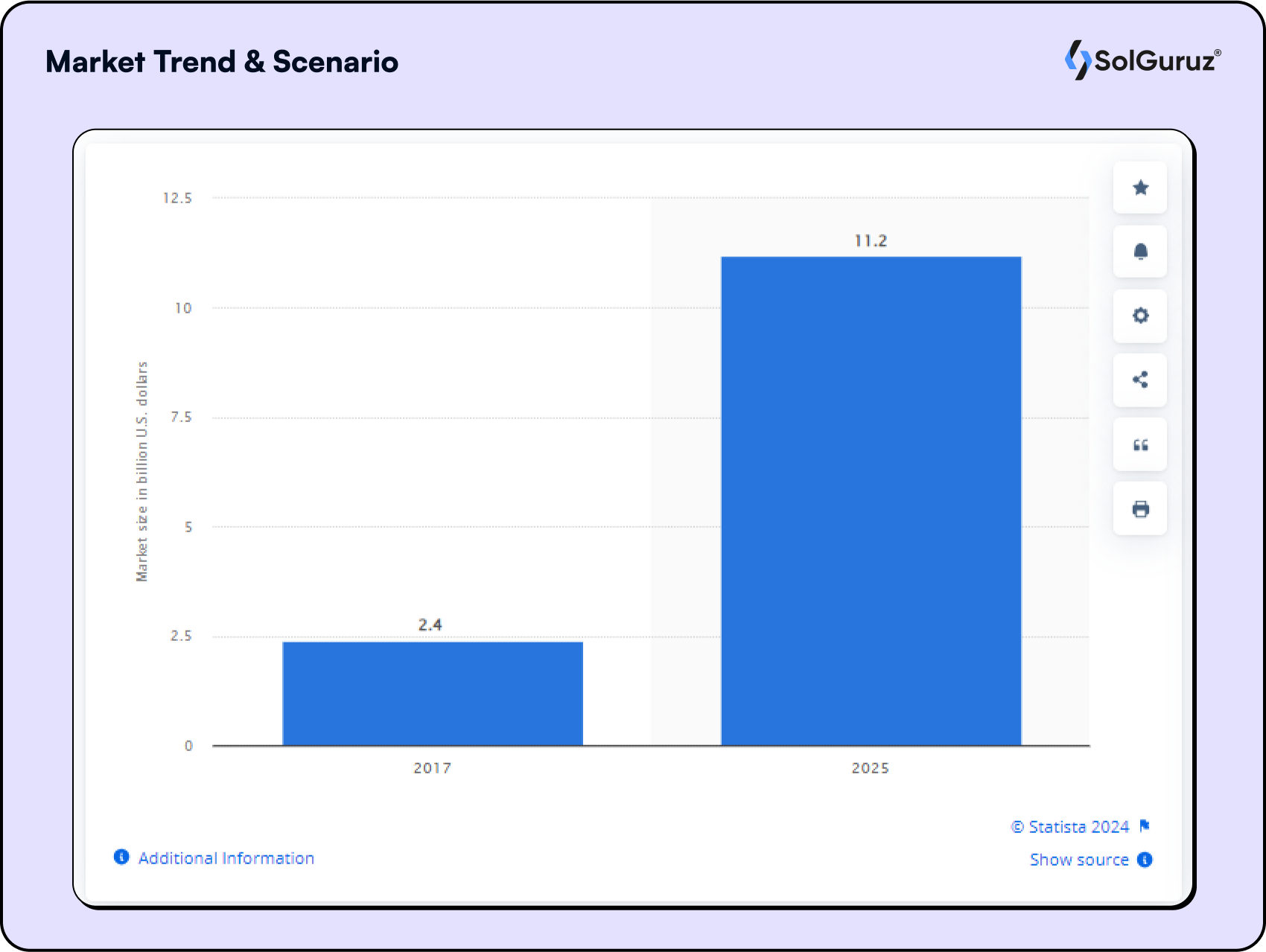
According to the market research report released by Global Market Estimates, the global market for medical apps was valued at around 2.4 billion U.S. Dollars in 2017. The report also predicts that this market will experience growth and is projected to reach over 11 billion dollars by the year 2025.
Additionally, the same report states that the Global Nurse Scheduling Software Market (You can call it the nurse staff scheduling app) is expected to grow at a compound growth rate (CAGR) of 16.5% from 2023 to 2028.
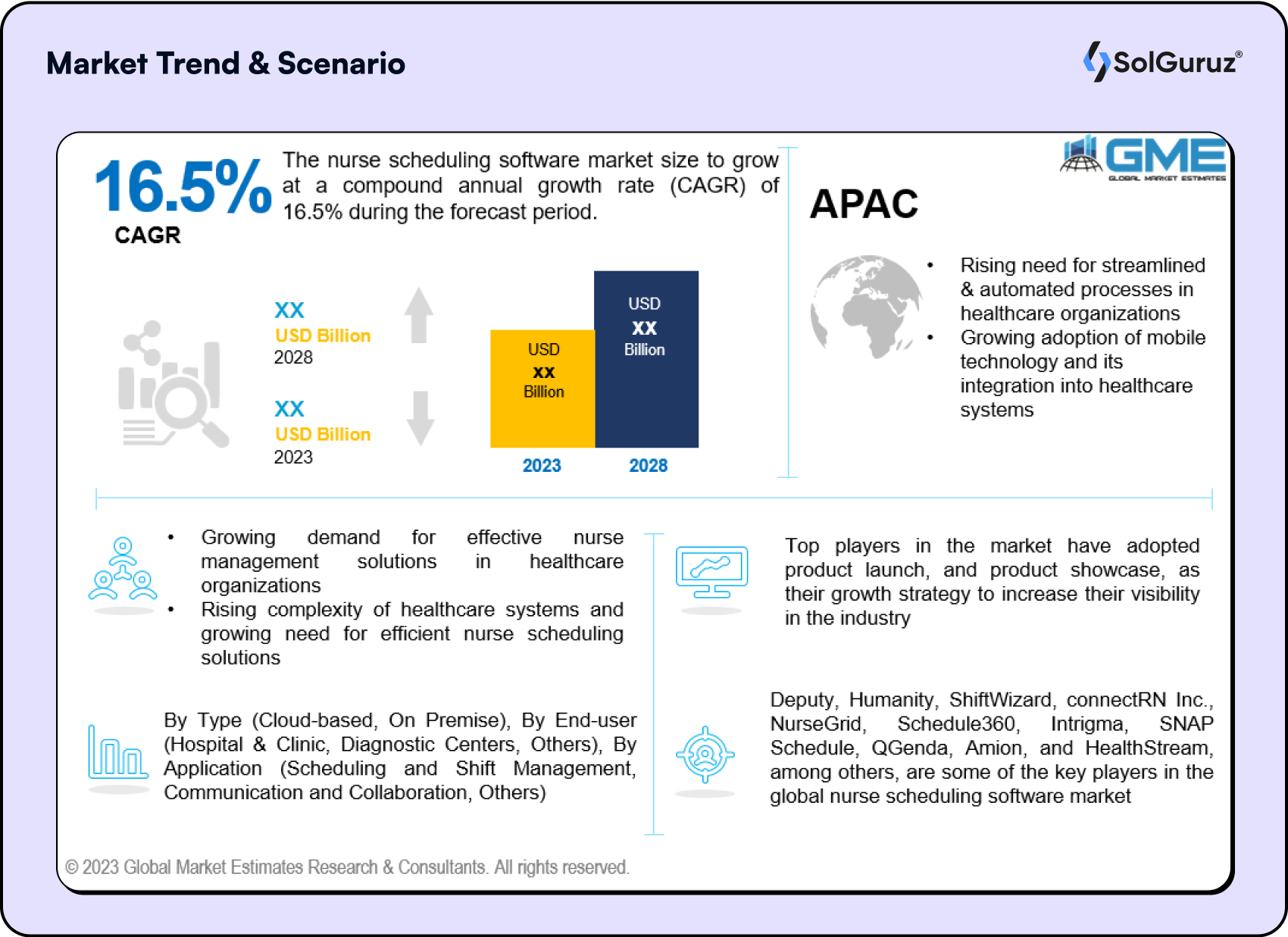
Just picture yourself trying to handle the staffing requirements of a nursing home while also putting resident care and following strict regulations at the top of your priority list.
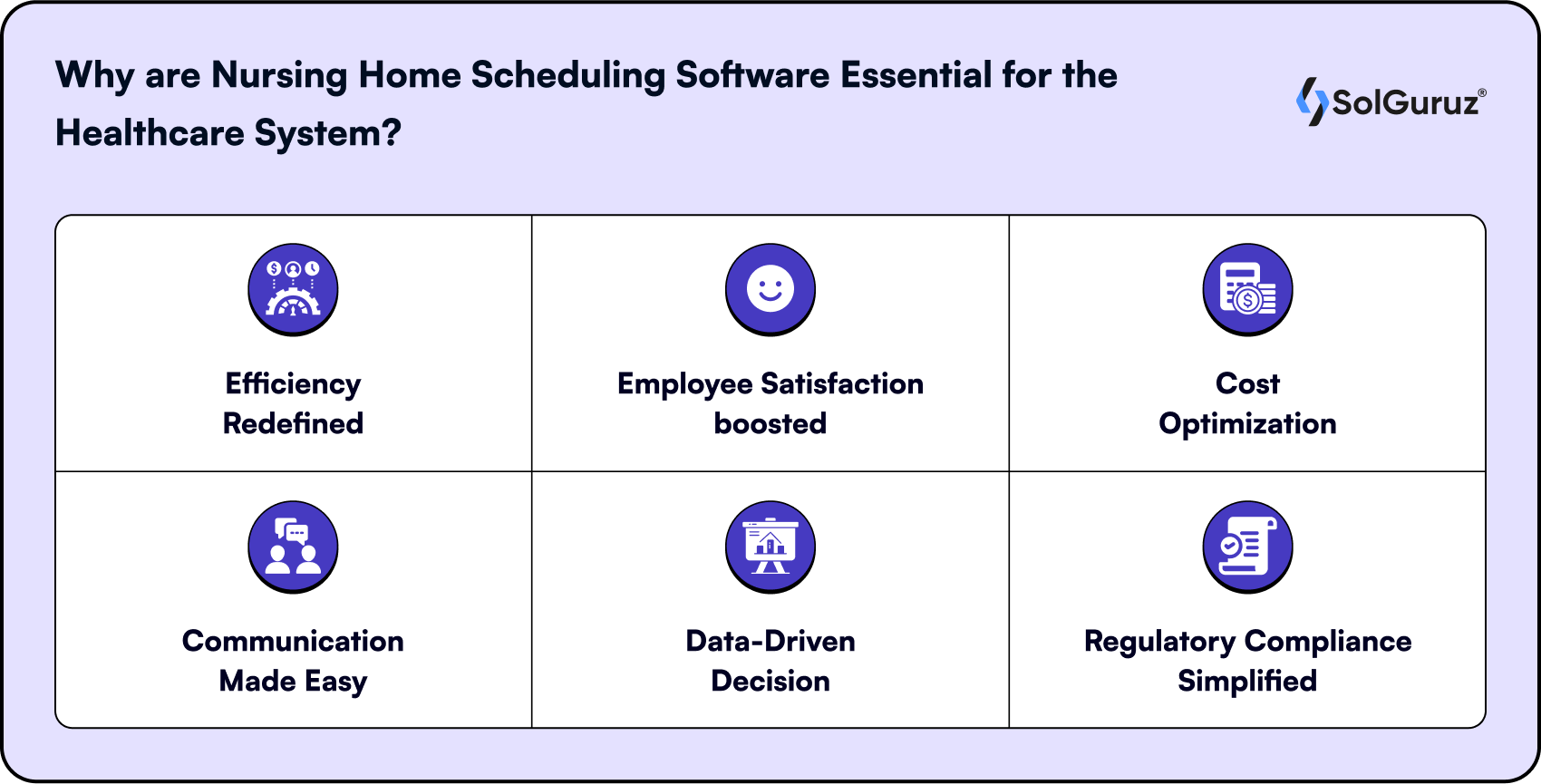
It’s a struggle for administrators, which is why nurse staffing apps, nursing staffing software, nursing scheduling software or nursing scheduling apps have become essential.
In this discussion, we’ll explore the reasons why this kind of software is no longer seen as a luxury but a vital necessity for modern nursing homes:
Gone are the times when paper schedules and ending phone calls ruled the day. Thanks to nurse staffing apps, administrators can now automate the process, saving up to 70% of their scheduling time.
These clever algorithms take into account factors such as nurse qualifications, preferences, and resident needs to create schedules that are fair and well-balanced. This not only minimizes conflicts but also guarantees that staffing levels remain adequate at all times.
In the demanding nursing field, following schedules often result in burnout and a high rate of turnover. However, there is a solution: nursing scheduling software. This software gives nurses control and flexibility over their schedules.
They can easily request time off, exchange shifts with their colleagues, and access their schedules around the clock through user nursing scheduling apps. By providing this level of convenience it helps improve the work-life balance, for nurses leading to more engaged healthcare professionals who can provide better care to the residents they serve.
Efficient staffing translates to cost savings. Nurse staffing apps help optimize staff allocation by considering resident acuity levels, historical data, and anticipated demand fluctuations. This reduces the need for overtime and agency staffing, leading to significant cost reductions for nursing homes.
In healthcare, having communication can lead to outcomes. Nurse staffing apps serve as a centralized platform that promotes ongoing communication among administrators, nurses, and other departments.
Through these apps, staff members receive notifications regarding any changes in schedules, available shifts, and important updates. This ensures that everyone is well informed and working together towards the goal.
The software doesn’t just generate schedules; it thoroughly examines them. Healthcare administrators can obtain information and insights regarding staffing patterns, overtime expenses, and nurse effectiveness.
This allows them to make informed choices regarding staffing requirements, budget distribution, and initiatives for workforce development.
Dealing with the regulations of nursing homes can be quite overwhelming. However, nurse staffing apps come to the rescue by simplifying compliance through automated considerations of rest periods, overtime limits, and skill requirements during scheduling.
This effectively minimizes the chances of violations and the accompanying penalties.
To sum it up, nurse staffing apps, nursing staffing software, nursing scheduling software or nursing scheduling apps are not tools; they represent transformative solutions for the healthcare system.
By streamlining processes, boosting staff satisfaction, optimizing costs, and ensuring adherence to regulations, they pave the way for a future where nurses feel appreciated, residents receive outstanding care, and nursing homes prosper.
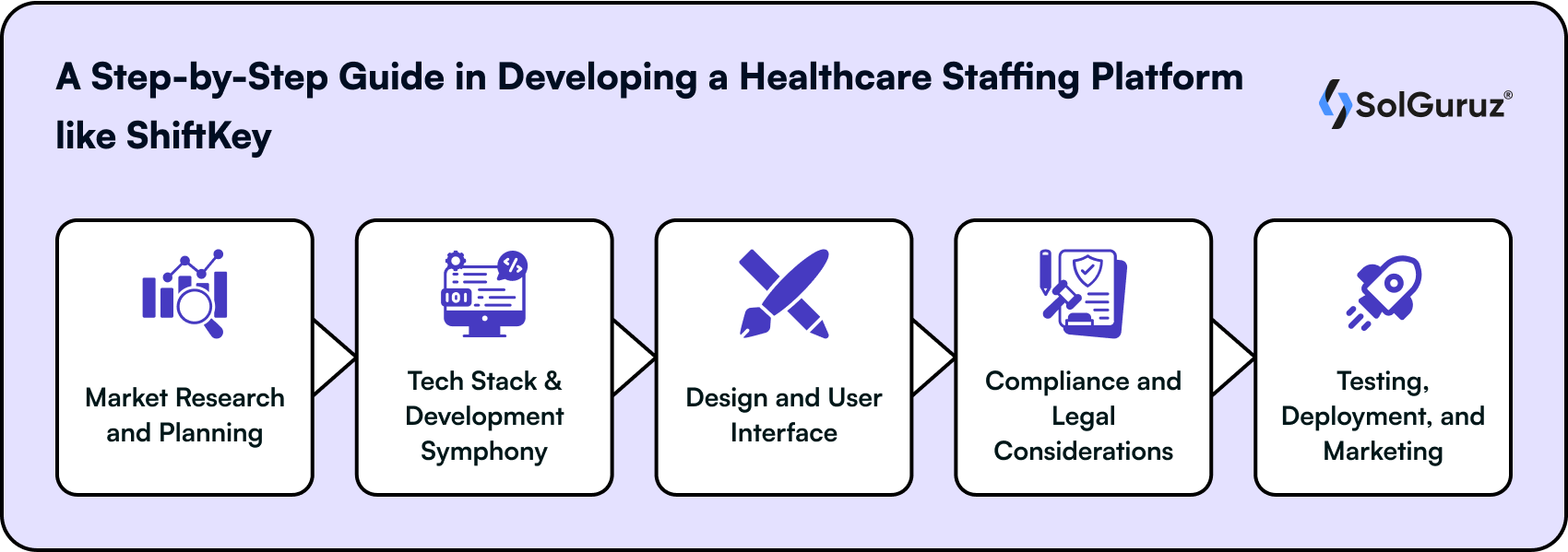
The healthcare industry craves efficiency, and innovative platforms like ShiftKey are stepping up to the plate. However, carving your niche in this space requires meticulous planning and execution. Here’s a roadmap to guide you through the development journey:
Begin by pinpointing your target audience. Are you catering to specific regions, specialties, or facility types? Competitor analysis is crucial – their strengths and weaknesses inform your unique value proposition.
Now, prioritize features based on market needs and your budget. Core functionalities might include automated scheduling, shift swapping, user-friendly job platforms, secure communication channels, credential verification, and robust analytics.
Decide whether your platform will be web-based, mobile-centric, or both. User needs and budget should guide your choice. Next, select secure and scalable technologies – programming languages, databases, cloud infrastructure – that fit your vision. Focus on building core functionalities for your Minimum Viable Product (MVP) first, ensuring quality and functionality before expanding.
Finally, security is paramount. User authentication, data encryption, and compliance with healthcare regulations (HIPAA, etc.) are non-negotiable.
Prioritize user experience. Both healthcare facilities and professionals deserve intuitive interfaces. A mobile-first approach is essential, as smartphones are often the primary access point. Remember accessibility – cater to users with diverse needs and abilities.
Healthcare can be quite intricate. It is essential to have an understanding of data privacy regulations, labor laws, and relevant specific requirements for your intended audience.
Maintaining data security is necessary to safeguard information about patients and healthcare professionals. Engaging advice will help ensure that your platform operates within the boundaries of the law.
Rigorous testing for functionality, security, and performance is vital. Conduct a soft launch to gather early adopter feedback and refine your platform. Finally, develop a targeted marketing strategy to reach your ideal audience. Engaging with healthcare professionals and facilities builds a community and fosters platform adoption.
Remember: Start small, scale iteratively, and prioritize data security and privacy. Continuously collect user feedback, track performance metrics, and adapt your platform based on insights. Building a successful healthcare staffing platform requires dedication and flexibility.
By following these steps and tailoring them to your vision, you can create a valuable tool that benefits both healthcare professionals and facilities and contributes to a more efficient, patient-centred future.
In the realm of healthcare staffing applications, differentiating oneself necessitates a strong emphasis on features that genuinely enhance the experiences of both nurses and healthcare facilities. Here are several crucial aspects to prioritize when developing your scheduling application for nurse staff:
Intuitive Interface: Streamline the user experience with a user-friendly and mobile-first design. Makeshift selection, shift swaps, and communication are effortless.
Flexibility and Control: Empower nurses with some control over their schedules. Consider features like self-scheduling options, preference selection, and shift swap functionality within clear guidelines.
Transparency and Communication: Ensure real-time updates on schedules, open shifts, and important information through push notifications and messaging within the app.
Fairness and Equity: Employ algorithms that fairly distribute workload and consider nurse qualifications and preferences during scheduling. Promote transparency in shift allocation and overtime opportunities.
Work-Life Balance: Cater to diverse needs by offering a variety of shift lengths and configurations (e.g., 8-hour, 12-hour, split shifts). Allow for time off requests and consider integrating with personal calendars.
Compliance and Security: Ensure the app adheres to all relevant labor laws and regulations, including overtime restrictions and rest periods. Prioritize secure data storage and user privacy.
Efficient Scheduling: Use algorithms and data analysis to optimize staffing by considering requirements, historical data, and anticipated fluctuations in demand. This approach will help minimize the need for scheduling and reduce overtime expenses.
Compliance and Legal Considerations: Incorporate functionalities that guarantee compliance with labor laws, licensing obligations, and regulatory guidelines. Streamline procedures such as recording working hours and calculating wages.
Communication and Collaboration: Enable efficient communication among nurses, managers, and other departments by integrating messaging and notification systems.
Cost Optimization: Optimize the allocation of staffing resources. Reduce overtime expenses by utilizing data-driven insights to minimize scheduling inefficiencies.
Performance and Analytics: To enhance efficiency in scheduling decisions, it is crucial to monitor indicators such as shift coverage, overtime rates, and nurse satisfaction. By analyzing these metrics, areas for improvement can be. Future scheduling can be optimized.
Scalability and Integration: Build an app that can adapt to the growth of your facility and integrate seamlessly with existing HR and payroll systems.
Advanced Features: Consider adding features like skill matching, travel nurse integration, or certification tracking to cater to specific needs and attract a wider talent pool.
Gamification and Incentives: Explore ways to motivate nurses through gamified elements or reward systems for completing shifts or adhering to scheduling preferences.
Community Building: Encourage a feeling of togetherness among nurses by integrating elements such as forums, interactive discussion boards, or mentorship initiatives within the application.
While understanding the core types of nurse schedules is crucial, the world of healthcare staffing unfolds like an intricate tapestry.
Here, we explore some additional, nuanced scheduling variations you might encounter:
Compressed workweeks: Nurses work longer daily shifts for fewer days per week, allowing for extended periods off.
Per diem staffing: Agencies provide nurses daily to fill specific needs, offering flexibility but less stability.
Travel nursing: Nurses temporarily work at different facilities across locations, experiencing diverse environments and patient populations.
Surgery schedules Often involve unpredictable shift lengths due to varying procedure durations, demanding flexibility and quick thinking.
Home care schedules: This role may involve working shifts and traveling between the homes of patients, so it’s important to have time management and organizational skills.
Outpatient schedules: Usually, healthcare professionals tend to adhere to the 8-hour or 10-hour work shifts, coinciding with the operating hours of clinics.
10-hour shifts: For nurses who desire a balance between days and shorter daily commutes, these options provide a middle ground ranging from around 8 to 12 hours.
Flexible shifts: Split shifts, such as morning and evening schedules or shifts of varying lengths based on patient care requirements, maybe a part of the nurse’s job, which requires nurses to be adaptable. It’s important to keep in mind that this is a glimpse into the wide-ranging realm of nurse scheduling.
Each healthcare facility, specialty area, and even individual nurses may have their own needs and preferences. By understanding these variations, we can enhance scheduling to prioritize care while also considering the well-being of our staff members.
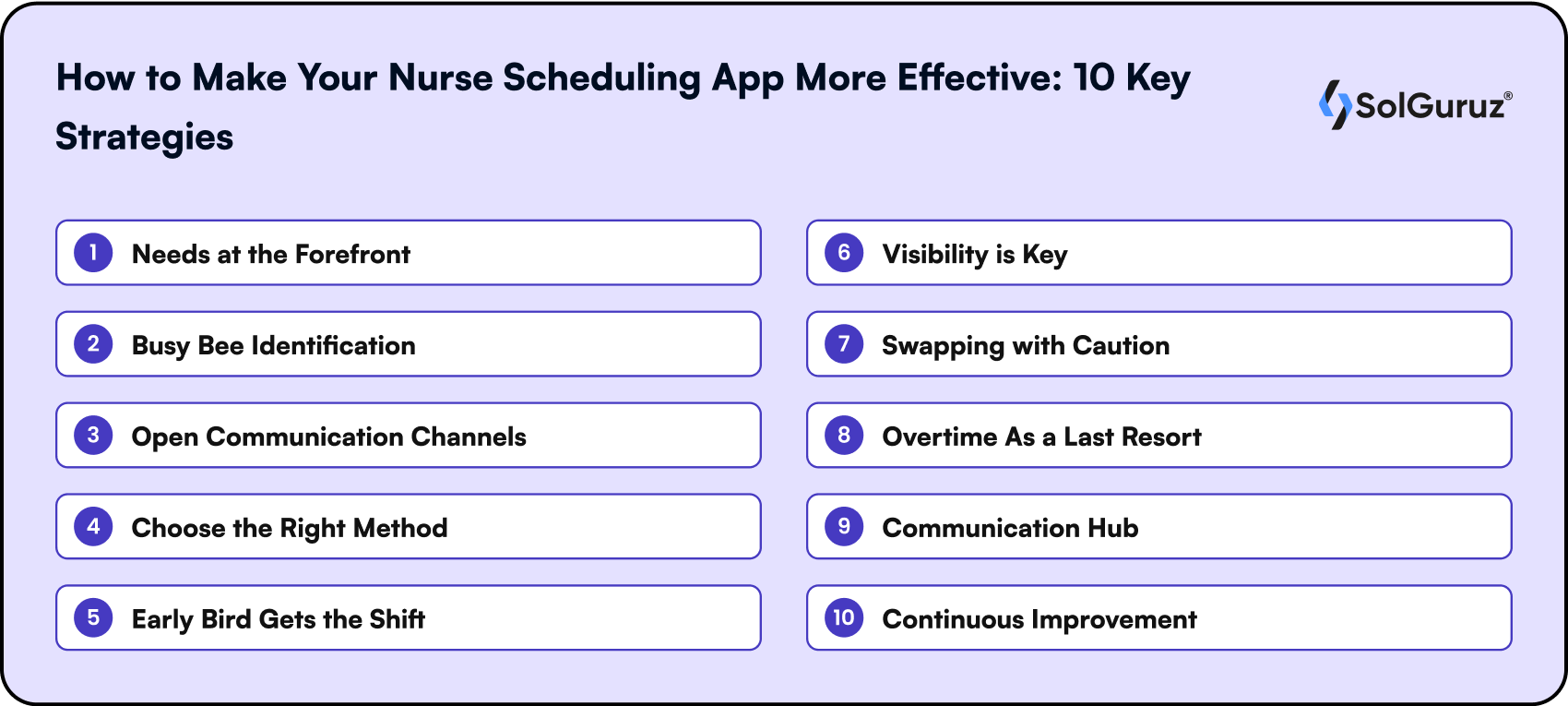
To maximize the potential of your nurse scheduling app and ensure its effectiveness, it is crucial to go beyond functionality. Here are ten practical strategies that can help you fully utilize its power and establish a scheduling system that benefits both your nurses and your facility:
Start by diving deep into your nurses’ needs. What kind of shifts do they prefer? Do certain specialties require unique scheduling considerations? Understanding their needs helps tailor the app to their experience.
Pinpoint your peak patient influx periods. This allows you to optimize staffing during these times and proactively avoid understaffing in critical moments.
Let your nurses voice their preferences! Empower them through the app to express their desired shifts, availability, and any limitations.
Not all nurse scheduling methods are created equal. Evaluate different options based on your needs and preferences, be it self-scheduling, rule-based algorithms, or a hybrid approach.
Avoid last-minute scrambling by creating schedules well in advance. This gives nurses ample time to plan their personal lives and reduces stress.
Ensure seamless distribution of schedules through the app, accessible from any device. Push notifications and reminders keep everyone informed and on the same page.
Allow controlled and monitored shift swaps within the app. This fosters flexibility but requires safeguards to avoid conflicts and ensure adequate coverage.
Overtime fatigue can impact the quality of care and staff morale. Use the app to optimize scheduling and minimize the need for last-minute overtime whenever possible.
Foster seamless communication within the team through the app. Real-time messaging helps address shift needs, share updates, and maintain clear communication between nurses and administrators.
Don’t settle for “good enough.” Regularly evaluate your scheduling system through app analytics, user feedback, and performance metrics. This data guides you in making informed adjustments and continually refining your approach.
By embracing these strategies, your nurse scheduling app will transform from a simple tool into a strategic asset. It will empower your nurses, streamline your operations, and ultimately contribute to a more satisfied workforce and exceptional patient care. Remember, the journey to effectiveness is an ongoing process, so stay committed to listening, adapting, and innovating!
In conclusion, developing a nurse staff scheduling app like ShiftKey can be a game-changer in the healthcare industry, streamlining scheduling processes and improving efficiency for healthcare facilities and professionals alike. However, the journey from idea to execution requires expertise, dedication, and the right partners.
If you’re looking to bring your vision to life and ensure success in this venture, connecting with SolGuruz can make all the difference. With our experience in developing innovative healthcare solutions and our commitment to delivering high-quality services, we can help you navigate every step of the development process. Plus, by partnering with SolGuruz, you’ll gain access to the best rates and unparalleled support to turn your idea into a reality.
Don’t let the opportunity slip away. Reach out to SolGuruz today to take the first step towards building your nurse staff scheduling app and revolutionizing the healthcare staffing industry.
Not quite! While perfect scheduling may seem like a unicorn, the goal is to find a system that optimizes both staffing needs and individual preferences. This involves considering factors like patient acuity, department requirements, nurse experience, and personal needs. Different approaches, like 8-hour, 12-hour, or flexible shifts, may work for other facilities and individuals. Open communication and data-driven analysis are key to finding the sweet spot.
Not necessarily! While longer shifts demand more physical and mental stamina, some nurses enjoy the condensed workweek and extended off days. Effective fatigue management strategies, strong support systems, and well-designed schedules can minimize burnout risks. Ultimately, individual preferences and workplace factors play a crucial role.
Gone are the days! Nowadays, numerous nurse scheduling applications provide the option for nurses to schedule their shifts, express their preferences, and swap shifts within guidelines. However, it's important to note that there are still limitations and considerations to ensure coverage. The degree of control over self-scheduling varies depending on the application and facility policies.
No way! Even though apps can make tasks easier and improve communication, they shouldn't replace interaction. The best scenario is for apps to help nurses and managers communicate better so they can have conversations about their preferences, concerns, and workload. It's important to maintain a human connection to create a collaborative work environment.
Absolutely! When we optimize the staffing levels, address fatigue concerns, and enhance communication, it greatly contributes to creating an environment, for both patients and staff members.
Written by
Paresh is a Co-Founder and CEO at SolGuruz, who has been exploring the software industry's horizon for over 15 years. With extensive experience in mobile, Web and Backend technologies, he has excelled in working closely with startups and enterprises. His expertise in understanding tech has helped businesses achieve excellence over the long run. He believes in giving back to the society, and with that he has founded a community chapter called "Google Developers Group Ahmedabad", he has organised 100+ events and have delivered 150+ tech talks across the world, he has been recognized as one of the top 10 highest reputation points holders for the Android tag on Stack Overflow. At SolGuruz, we believe in delivering a combination of technology and management. Our commitment to quality engineering is unwavering, and we never want to waste your time or ours. So when you work with us, you can rest assured that we will deliver on our promises, no matter what.
Sign up for our free newsletter
